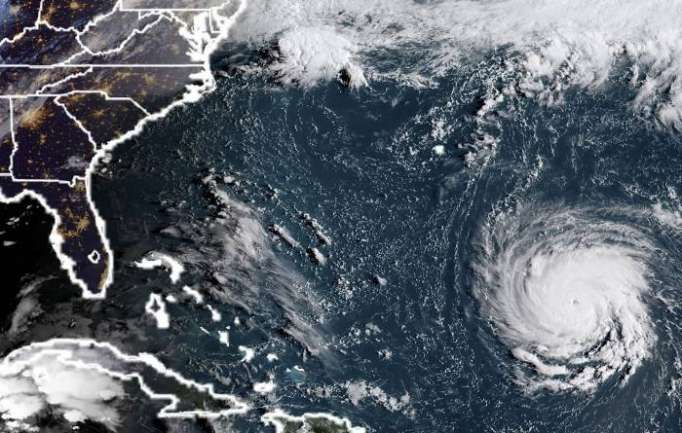The powerful Category 4 Atlantic weather-front is slow moving, an increasingly common phenomenon that poses a different manner of threat to states in its path.
In the event that Florence stalls or comes to a halt altogether over land, it has the potential to deposit catastrophic quantities of rainwater, posing a risk of severe flash flooding.
While the high winds and waves generated by faster storms moving inland from the ocean pose a significant danger to human life and property, the effect of heavy rain can be just as devastating, if not more so.
When Hurricane Harvey hit in August 2017, it dropped 60 inches of rain over Houston, Texas, flooding the streets, leaving 93 dead and hundreds more having to be rescued by boat, causing millions of dollars-worth of damage.
James Kossin of the National Oceanic and Atmospheric Administration published a study in the journal Nature in June suggesting that slow-moving tropical cyclones, which would include those like Florence and Harvey, have become more common over the last 70 years, dropping in speed by 10 per cent in that time.
According to Mr Kossin, global warming as a result of man-made air pollution is causing the poles to become warmer, which in turn reduces the difference in temperature between the Arctic and Antarctic and the equator, altering atmospheric pressure and slowing down the whipping currents of wind that pass between them and drive hurricanes.
The weakening of these winds has also been blamed for the stalling that gave rise to this summer’s UK heatwave.
Mr Kossin’s findings echoed those published by the American Meteorological Society a year earlier, studying the passage of 22 hurricanes since 2004 and concluding that future storms would drift more slowly and pose their greatest threat to man from heavy downpours.
Slower storms also mean they are likely to linger for longer, increasing the likelihood of property damage.
“If the wind’s blowing very hard against the structure and it blows a few more hours than it would have, the likelihood of knocking that structure down increases,” Mr Kossim told NPR.
“You get more rainfall, you get more wind damage. You also get more storm surge. Slower storms will have a tendency to push a larger wall of water in front of them. So it’s really a triple threat.”
Warmer air and water as a result of heat being trapped in the atmosphere by greenhouse gases – present as a result of our burning fossil fuels in cars, power plants and aeroplanes – also increases the amount of vapour a storm can carry, meaning even more rain.
This is thought to have fuelled the devastation Harvey caused, said scientists from the National Center for Atmospheric Research (NCAR), who wrote in the journal Earth’s Future in May that the Gulf of Mexico was then experiencing abnormally high ocean temperatures of 30C.
“Record high ocean heat values not only increased the fuel available to sustain and intensify Harvey but also increased its flooding rains on land,” NCAR climate scientist Kevin Trenberth observed.
Harvey was able to feed off the heat stored in the 930-mile wide basin as it headed north towards Texas, its winds strafing the surface and picking up water through evaporation, a process requiring heat and one therefore encouraged by the unusually warm temperatures of the upper ocean.
“The implication is that the warmer oceans increased the risk of greater hurricane intensity and duration,” Mr Trenberth said.
Whereas climate scientists were once much more reluctant to say for certain that global warming was directly responsible for causing an upsurge in extreme weather events, they have become increasingly emboldened to do so in recent years, under the influence of American geophysicist Michael E Mann and others.
The evidence provided by studying recent “super-storms” like Harvey and Florence makes their case even more compellingly.
The Independent
More about: climate
















































